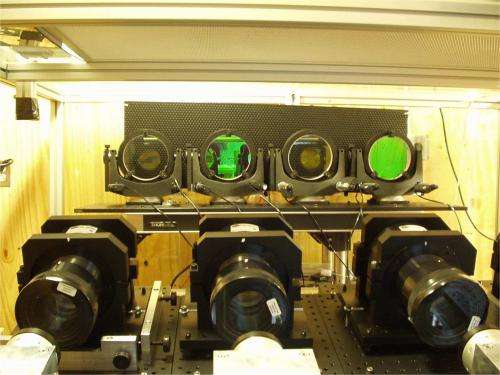Incoherent combining of fiber lasers developed for directed energy applications

Developed at the U.S. Naval Research Laboratory, Plasma Physics Division, incoherent combining of high power fiber lasers for directed energy (DE) weapons and power beaming have proven effective in laser weapon systems (LaWS) prototypes now being temporarily deployed onboard select Navy ships.
Based on architecture first proposed in 2005 by Dr. Phillip Sprangle, senior scientist, NRL Directed Energy Physics, validation tests of incoherent laser beam combining began as early as 2008 by NRL researchers at the Starfire Optical Range, Kirtland Air Force Base, New Mexico.
Validating propagation models, the tests demonstrated the concept at long-range, quantified thermal blooming effects, and more precisely, characterized beam wander and spread.
"The physical processes affecting the propagation of high-power laser beams in the atmosphere are complicated and interrelated," said Sprangle "These field experiments provided proof of concept, laying the groundwork for developing a tactical directed-energy laser system in the near-term."
Advances in solid-state lasers have made them candidates for DE applications. Individual, single-mode, fiber lasers can now produce approximately 10 kilowatts (kW) of continuous power.
To achieve the necessary power levels, large numbers of fiber lasers must be combined. Incoherent combining of laser beams is achieved by overlapping the individual laser beams on a target with a beam director consisting of independently controlled steering mirrors with optional adaptive optics capabilities.

"Incoherent combining of fiber lasers has a number of advantages," Sprangle said. "It does not require phase locking or polarization locking of the individual lasers and can be readily scaled up to a compact and reliable directed energy system."
Single-mode fiber lasers are well suited for incoherent combining and high-power, long-range DE applications. Individually controlled steering mirrors with adaptive optics capabilities form the beam director and direct each beam to the target. Incoherent combining of high-power fiber lasers can result in highly efficient, compact, robust, low maintenance, and long-lifetime high-energy laser systems for directed energy applications.
The laser system, which is based on incoherently combining high-power fiber lasers—necessary to propagate the beam many kilometers in a turbulent atmosphere—is suitable for strategic and tactical directed energy applications. These include: shipboard missile defense, small craft defense, and power beaming to unmanned aerial vehicles (UAVs).
At sea, conventional UAVs may be limited by flight or hover endurance, launch and landing capabilities, and payload capacity. Typically used for over-the-horizon observation, surveillance and communication, many ship-based UAVs must rely on a tethered power and communications links. Laser power beaming effectively eliminates this need, allowing greater mission flexibility and efficiency.
As a laser weapons system, incoherent lasers offer a highly cost effective, all electric, instantaneous long-range targeting and delivery system.
Sponsored by the Office of Naval Research (ONR) and the Joint Technology Office (JTO), cost effective directed energy systems increase the efficiency, safety, and capability of the U.S. Navy and meet the needs of Next-Generation Integrated Power Systems (NGIPS) platforms necessary for next-generation all-electric ships.
Provided by Naval Research Laboratory



















